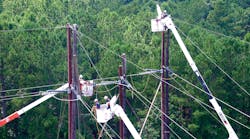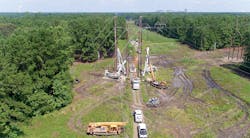Back in the 1970s, Santee Cooper, South Carolina’s state-owned utility, built wooden H-frame structures on a three-mile 230 kV radial line to serve an industrial customer with 24/7 operations. Any time the customer has to shut down for a scheduled outage, it loses a significant amount of production, resulting in lost revenue. As a result, the last scheduled maintenance under an outage was in 2003.
The utility’s crews performed energized maintenance as identified in annual line inspections, commonly using stub poles and pole enforcers to shore up weaker structures. Any maintenance that could be performed safely was accomplished under hot-line work permits—from bird damage repair and prevention to complete tangent structure change-outs.
This approach provided an unprecedented level of uninterrupted service for the line. However, it left the utility with four structures in critical need of repair, three dead-end structures and a tangent structure at a critical transmission crossing that would require an outage or series of outages to replace.
Creating a Plan
Santee Cooper performed a risk analysis showing the customer three proposed work plan scenarios based on 48-hour, 72-hour and 96-hour outage windows. The risk analysis showed that the line was in dire need of significant work. After meeting and discussing the three options, it was agreed that a 48-hour outage option with “hot work” for two days prior to the outage and two days after the outage would be the best option.
By spreading out the “hot work,” the schedule more closely aligned with the customer’s two-day shutdown and two-day startup processes. Therefore, it minimized the potential impact on the customer’s system if an inadvertent outage were to occur during the energized maintenance.
Prior to the outage, Santee Cooper’s in-house transmission line maintenance department coordinated with the in-house substation maintenance group to devise a plan so the utility could accomplish as much work as possible during the scheduled outage.
Working Together
Before the scheduled 48-hour outage, Santee Cooper removed an oil-filled circuit breaker and replaced it with a new SF6 gas breaker and replaced two tangent structures on the energized line. Then during the two-day outage in mid-August, the crews replaced seven structures, installed surge arrestors and jumpers for the substation breaker replacement and replaced damaged cross arms on two tangent structures.
Santee Cooper, which serves about two million people in all 46 counties in the state of South Carolina, has 11 in-house transmission line crews throughout the state. The state is split into three crew territories: the Central area, the Southern area and the Northern area. The linemen from various crews/areas came together like the players on a baseball team, and they were led by a good coach — area supervisor Mark Marsh — who led the workers to the finish line.
Marsh not only had to coordinate with all the crews, but he also had to coordinate with Santee Cooper’s internal distribution operations crew, substation maintenance crew, right-of-way department, and safety group. He also had the forethought to have some mechanics on site to minimize any delays due to equipment issues that might arise.
Facing Challenges
As with any fast-paced construction project, Santee Cooper crews faced their share of challenges on the job. Temperatures soared to 90-plus degrees with 100% humidity. The week before, three inches of rain fell on the work site, creating muddy conditions for the crews.
In one area of the job, the water was 2 to 3 ft deep near a structure that was being replaced. Because of these muddy conditions, the crews had to access the right-of-way using equipment such as flex track buckets and flex track digger derricks.
The project was a challenging but highly effective operation that closely simulated the types of pressures and coordination necessary for storm recovery. At the end of the project, the crews was able to replace one breaker, three surge arrestors and one continuously variable transmission (CVT).
In addition, the linemen changed out nine structures and bird wrapped or repaired 18 additional structures. Since woodpeckers are prevalent in South Carolina, the distribution crew “bird buddied” the poles and was able to wrap and fix every single structure that showed any sign of damage. Through teamwork and advanced planning, the utility wrapped up the job 12 hours early.
Through the efforts and hard work of all who were involved on this project, Santee Cooper was able to significantly improve the reliability of the power line, replace aging poles and equipment, and prepare to meet the customer’s future needs.





